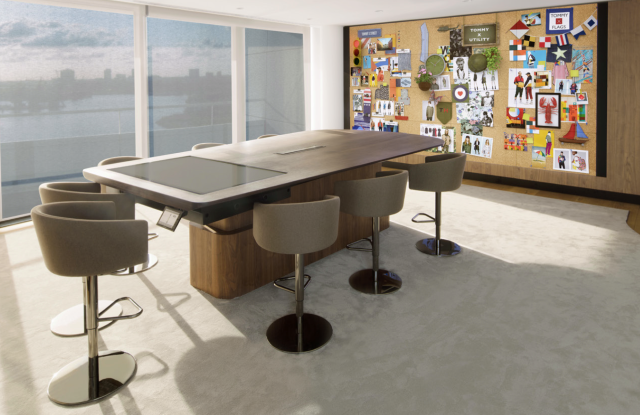Are Virtual Showrooms the New Standard in Wholesale? – WWD
Trade shows and runway presentations may be staging a comeback, but with many, if not all, industry professionals unable to travel due to the pandemic companies must continue to rely on technology to showcase new seasons.
Virtual showroom technology has grown significantly in light of the pandemic, offering brands the ability to host wholesale appointments that capture the experience that a buyer would have had in-person. The immersive digital showrooms can be designed to look identical to a brand’s physical showroom and even allow the user to navigate the environment without the usual restraints and challenges that physical space encounters.
A report by WWD, early in the pandemic said the “implementation of virtual showrooms and livestreaming, which are already defining the shopping experience in China, will become the new standard.” These tools will enhance the proactive approach for digital sales and even keep customers updated with a brand’s latest news.
Concurrently, a statement made by PVH said, “COVID-19 brought a new urgency to the need to go to market with a digital showroom experience for the customer that’s viable in the current sales environment and also addresses ongoing efforts to improve our environmental footprint. Similar to consumers at retail, our wholesale customers are seeking and more cost and time-efficient selling tool solutions that meet their evolving needs.”
As the pandemic continues and new challenges are brought to light, PVH is just one company that is “actively using the power of virtual showrooms to create a more customized and interactive experience” with products.
Hatch
Hatch, part of PVH brands, was created at Tommy Hilfiger in 2015 and quickly “brought immense value to the company” in its ability to reduce samples, speed up time-to-market and ensure global brand alignment across the company’s wholesale selling. The success of Hatch eventually led to scaling the digital showroom across PVH brands and locations with an emphasis on Tommy Hilfiger and Calvin Klein. And more recently, the company has signed clients outside of the PVH umbrella.
“Digitization of wholesale selling is a key step toward a more sustainable and efficient future for fashion,” said Anne-Christine Polet, senior vice president, digital business ventures, Hatch and Stitch, PVH Europe. “And it can be done without losing the experience that brands still want to offer their customers. We see so many opportunities to enhance digital selling even more and convince more brands to join in this movement. Digital showrooms are a key element for brands to adapt to this ever-changing world. The flexibility the software offers while maintaining a great experience and connection with the buyer is what makes this so compelling, even beyond COVID-19.”
Joor
Joor established itself as one of the leaders in the digital wholesale space and offers a host of tools to support b-t-b selling, including its virtual showroom technology. In addition to 3-D imaging and video, features like The Edit let brands present style boards to buyers that allow for greater collaboration and customization. The company also offers Joor Passport, which scales the virtual showroom experience and re-creates trade show events for many global organizers.
“Ten years of integrated brand partnerships serve as the core of our industry-leading platform,” said Kristin Savilia, chief executive officer of Joor. “Other solutions are dependent on manual uploads thus limiting the ability and opportunity to participate in collaborative commerce. Joor’s fully digital ecosystem is the best solution for the advancement of both brands and retailers.”
Since launching in 2010, Joor has established an expansive network of more than 8,600 brands and 200,000 fashion retailers. The platform is particularly focused on the luxury segment, claiming to represent 75 percent of luxury brands on the market, and also offers a specific retail product that complements the brand product. With 24/7, 365-day accessibility, Joor’s platform aims to free the buying process from the traditional fashion calendar.

ByondXR virtual showroom.
Courtesy Image.
ByondXR
Industry veterans, Noam Levavi and Eran Galil launched ByondXR in 2016 with the goal of helping brands, wholesalers and retailers “go through the critical digital transformation that will let them lead and excel in an ever-changing environment.”
The platform’s interactive platform digitizes the E2E retail fashion process from design to sales and ordering. A virtual store simulation allows users to display merchandise in a real store-like environment, display outfits and assortments on store fixtures, use intuitive UI to drag and drop and reorganize the store and display performance data with real-time integration to ERP/PLM. At the same time, the platform’s 3-D e-commerce aims to enhance e-commerce experiences with immersive user journeys using 3-D, 360 environments that increase engagement and conversion.
“We have reached a technological maturity level which really pioneers the retail industry,” said Noam Levavi, cofounder and ceo at ByondXR. “Closed showrooms can now be open again via the ByondXR platform and become a thriving, sustainable business which provides real experiences in virtual environments.”
Ordre
Having first entered the virtual showroom space in 2014, Ordre is well-versed in the needs of buyers — and the opportunities presented by a virtual format. The original Ordre.com platform has turned its focus to emerging designers, providing access to a retail network of more than 9,000 buyers across 93 countries, while its Ordre Virtual function is specifically for established luxury designers.
“Emerging designers often rely exclusively on the development of a wholesale network for their initial growth and development,” said Simon Lock, founder and ceo of Ordre. “Ordre.com is a unique open network, allowing designers to search and reach out to leading retailers globally to develop relationships.”
Ordre.com utilizes the company’s own ORB360 imaging, video and virtual reality to create a comprehensive collection-viewing experience. The Virtual program lets designers host fully customizable virtual experiences on stand-alone web sites, with tours, appointments and order-taking built-in.
NuOrder
At NuOrder, the emphasis is on transforming the static digital line sheet into a dynamic online showroom and shopping experience. “What sets us apart from our competitors is scale,” said Heath Wells, cofounder and co-ceo of NuOrder. “We have seen our virtual showroom technology change the apparel industry on a global level and we are proud that our platform is being used by hundreds of thousands of top fashion brands and retailers around the world to power and enhance their wholesale buying.”
In addition to 360-degree imagery and shoppable videos, NuOrder’s platform deploys interactive shoppable hot spots. Brands can tag any image or video with a product “hot spot,” which is shoppable. The virtual showroom is also supported by a drag-and-drop function that lets users build their digital showroom exactly as they want, to best tell their brand and collection story. For purchasing, the EZ Orders tool lets users submit their orders from directly within their inbox.
Le New Black
With a lot of big names in the space, Le New Black has taken a different approach. The platform is focused on letting its users steal the show, with minimal branding of its own.
“Our white-label option is receiving a lot of attention as it allows users to create digital showrooms with a strong brand image, with no mention of Le New Black,” said Romain Blanco, managing director at Le New Black. “Customization is indeed the key to engage and immerse buyers remotely. Le New Black is part of a fashion tech ecosystem built on an exclusive partnership with the Fédération de la Haute Couture et de la Mode.”
Le New Black offers multiple customization options, from homepage and collection pages to invitations and news displays, so that the brand’s DNA is evident throughout the wholesale experience. Product pages showcase up to eight images, support video and include supporting product recommendations.
TradeGala
Meanwhile, fast fashion and short order fashion is the focus of TradeGala’s platform, which aims to help brands expand their international reach. The company pitches itself as the “simplest and most cost-effective way to expand into the international sector” and also offers a range of readily available products for those buyers who desire — or need — instant purchase.
“TradeGala has created a one-stop-shop for fashion purchasing online,” said Amber Domenech Patey, e-commerce project manager at TradeGala. “Hundreds of new products are added each week, from the constantly evolving brands portfolio exclusive to TradeGala. Retailers can find exactly what they’re looking for among the thousands of products available, with cutting-edge search technology, detailed filter options and personalized product recommendations specifically tailored to each buyer’s needs.”
Available categories include women’s wear, men’s wear, children’s fashion, accessories, shoes and gifts. The company also provides support for smaller or newer designers by sharing fashion news and insights, as well as helping them plan their buying schedule.

A BrandLab digital showroom.
Courtesy Image.
BrandLab Fashion
BrandLab Fashion was founded in 2016 by Jennifer Drury and Dan O’Connell, out of frustrations for the inefficiencies they were personally experiencing in the wholesale buying process.
The company’s 3-D digital format also enables brands to create a fully customizable landscape providing elements in the space that serve to highlight a brand’s DNA. Unlike other virtual showrooms, BrandLab Fashion’s fully integrated virtual reality showroom provides integrated voice or video communication linked to live ordering facilities, prioritizing communication and maintaining personal relationships. Between May and September 2020, BrandLab Fashion has hosted more than 2,000 live face to face sales appointments.
“We started 2020 seeing strong growth, mainly with brands seeking to improve their sustainability credentials and reduce the significant costs in wholesale buying,” said O’Connell, cofounder of BrandLab Fashion. “Then this accelerated massively due to COVID-19 and we saw a massive increase in inquiries and brands including HULA and Barbour adapting their showrooms to become virtual. The positive of COVID-19 is that it has given the industry time to reset and re-evaluate how we operate and look at new ways of doing things.”
Zedonk
Zedonk, which was acquired earlier this year by Dedagroup Stealth, focuses on helping small to medium-sized brands run production, wholesale and logistics processes. Not a virtual showroom option itself, Zedonk is integrated with Joor, Le New Black, Ordre and NuOrder. Orders taken on these platforms are synced across to Zedonk, allowing the brands to collate all orders and launch their products.
Zedonk’s ERP system allows users to cost their products accurately and when added to sales orders, forecast the exact amount of fabric or components needed to fulfill their production run. Notably, Zedonk has an off-line b-t-b sales app that allows users to send curated selections to existing customers. The app was created to streamline the order taking process while selling face-to-face or remotely.
“Many brands, who heavily rely on wholesaling, have had no other choice but to look into new ways of selling,” said Andrea Menè, director at Zedonk. “With international fashion weeks and tradeshows shifting to be digital, selling their collections virtually is the only way these brands are able to continue, for now.”
For More WWD Business News:
EXCLUSIVE: Olivier Rousteing’s Avatar Greets Buyers at Balmain’s Virtual Showroom
Fashion’s Rebound: Moving at the Speed of the Consumer
Mobile Devices Seen as Essential in Reaching Holiday Shoppers





